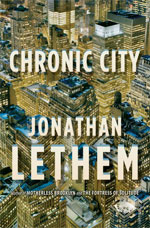
Chronic City by Jonathan Lethem feels like an unfettered frolic around an off-kilter and slightly imaginary Manhattan, but it turns out to be tightly and intriguingly choreographed. Tilting back and forth between the probable and the improbable, Lethem follows seemingly bland, naive former child star Chase Insteadman as he becomes enmeshed with a cast of colourful characters involved in the city’s cultural, countercultural and political milieus. Chase absorbs the charms and foibles of an eccentric Lester Bangs-like former rock critic, an attractive but embittered celebrity ghostwriter, a former political radical turned City Hall insider and fixer for the billionaire mayor – and absorbs from afar the wistful missives of a dying astronaut fiancee trapped in the International Space Station.
The increasingly askew city is being menaced by a marauding tiger that can stop traffic and apparently make buildings collapse. The city is further ravaged by peculiar and escalating weather disturbances. As Chase chases his troubled friends around the city and tries his best to give them the different kinds of love and support they demand, he also seems to be chasing some kind of oasis of sanity, safety and predictability in the midst of the maelstrom of a metropolis battered by strange forces. For a time, that safe haven seems to be an apartment building refashioned as a home for abandoned pets. But still, nothing and no one is what it seems to be. In a racing narrative peppered to the end with direct and sly indirect pop references galore, Chase keeps chasing to the last page before he finds sanctuary. The following quotation is perhaps a bit of a spoiler, but also best sums up what all the storylines and characters converge upon at the end:“The world was ersatz and actual, forged and faked, by ourselves and unseen others. Daring to attempt to absolutely sort fake from real was a folly that would call down tigers or hiccups to cure us of our recklessness. The effort was doomed, for it too much pointed past the intimate boundaries of our necessary fictions, the West Side Highway of the self, to shattering encounters with the wider real: bears on floes, the indifference and silence of the climate or of outer space. So retreat. Live in a Manhattan of your devising, a bricolage of the right bagel and the right whitefish, even if from rival shops. Walk the dog, dance with her to Some Girls. Why did Perkus have to be killed for his glance outside the frame? But maybe he hadn’t been killed, had only died. And again, maybe absconded. I was sick with ignorance, and my own complicity.”
When he does find sanctuary, the special payoff for the reader is that the tabula rasa central character has in fact absorbed and transmuted all of the confusion and deception (much of it unwitting self-deception) and distilled it into an emotionally authentic finish that will resonate for a long time.
